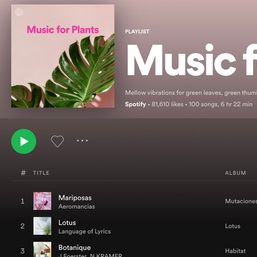SUMMARY
This is AI generated summarization, which may have errors. For context, always refer to the full article.

MANILA, Philippines – ICYMI: Plants are living things, too, that require tender loving care especially amid excessive heat.
But gardening isn’t for the weak. Melanie Arbias, a faculty member at the University of Santo Tomas Department of Biological Sciences, said that like children or pets, plants require the commitment of their owners to keep them alive.
“Hindi ‘yung ‘pag namatay, papalitan mo. Hindi magandang practice ‘yun,” she told Rappler. “Kapag ganoon ang notion mo na bibili ako ngayon, may pera ako, kahit hindi kita alagaan papalitan kita, huwag ka na maghalaman.“
(The practice of simply replacing plants when they die is not a good practice. If your notion is to buy plants now because you have the money and you can replace them if you can’t take care of them, then don’t take care of plants.)
Different plants need different amounts of sunlight to grow and survive. Too much exposure to heat, according to Arbias, could stunt their growth and development.
Owning plants at home has its benefits. Lillian Rodriguez, a faculty member at the University of the Philippines Institute of Biology, said that plants can provide more ventilation at home and help one’s mental well-being, among other things.
“When we see greenery, when we see them around us, it gives us positive feelings and positive emotions; it helps with people’s mental health. Just having even a small potted plant on your desk can help,” she told Rappler.
Here are some tips for plantitos and plantitas on how to keep gardens alive during this warm and dry season.
Plan your plants
When starting a garden, you must first consider what plants you want to get.
No two plants are the same – they each need different amounts of water, sunlight, and space to grow. Before planting, you should know what kind of maintenance your preferred plants require and if you are able to consistently provide what they need.
“We cannot protect something we cannot understand,” Arbias said. “Alamin mo kung anong pangalan, anong itsura, ‘yung field characteristics niya.” (Know its name, what it looks like, and its field characteristics.)
For beginners, Arbias recommended getting low-maintenance plants like philodendrons and succulents, which are more resilient amid extreme heat changing weather conditions.
Ferns, on the other hand, prefer cooler, shaded areas, according to Arbias.
Rodriguez also encouraged plantitos and plantitas to get plants that are native to the Philippines. She said that pandakaki and kamuning, for instance, are better suited for the country’s climate compared to most exotic, ornamental plants.
Right place, right time
Timing is essential. Although plants can generally survive high temperatures – provided that they are well taken care of – some plants may dry up or struggle to grow because of the heat.
Should you be interested in getting new plants, Rodriguez said that it may be best to wait until the end of the warm and dry season, which usually lasts until May.
“Mga plantitos, plantitas, stop muna ‘yung planting during the (warm and dry) season kasi mamamatay lang din ‘yun,” she told Rappler. “So, imagine ‘yung stress ng halaman na ‘pag nilipat mo siya ng bagong environment, tapos meron pa tayong drought.“
(Plantitos and plantitas should stop planting during the warm and dry season because their plants might die. Imagine the stress of the plant when you place them in a new environment amid the drought.)
You must also consider the space your plants will occupy. While it isn’t inherently bad to have exotic species, according to Arbias, carelessly planting them near native ecosystems may do more harm than good for the environment.
When unsure of the proper time and place to have certain plants, Arbias said that new plant owners can always consult landscape architects, horticulturists, or seasoned gardeners.
Be committed to care
As a plant owner, it is your responsibility to make sure that your plants receive the appropriate amount of water, sunlight, and nutrients they need to grow and thrive.
Rodriguez and Arbias recommended watering plants two to three times a day, preferably in the early morning or late afternoon.
“If you will notice, ‘pag sa tanghali mo siya diniligan, matutuyo lang din ‘yun nang sobrang bilis. Mas kayang ma-absorb ng halaman ‘yung water ‘pag hindi pa masyadong mataas ‘yung araw or towards [the] evening,” Rodriguez said.
(When you water plants during noontime, the water will dry up very fast. Plants can better absorb water when the sun has barely risen or toward the evening.)
Amid El Niño, the environment department encouraged Filipinos to avoid activities that consume a lot of water, like watering lawns and washing vehicles.
To conserve clean water supply at home, Rodriguez and Arbias said that plant owners can use recycled water – or water that has already been used for other household chores – to water their plants.
Some plants also require less sunlight than others. Arbias said that plantitas and plantitos may want to relocate their plants to a place with more shade if it tends to dry up when exposed to the sun.
“Dilig ka naman nang dilig, pero ‘yung halaman mo parang ang tuyo pa rin ang dahon, pag-isipan mo nang ilipat siya ng lugar. Baka ayaw niya talaga ng full sunlight,” she said.
(If you consistently water your plants, but the leaves are still dry, you may want to consider moving it to another place. Maybe it doesn’t like full sunlight.)
But be very careful when uprooting your plants as you could damage its root hair, which is responsible for absorbing water.
Say no to poaching
Rodriguez and Arbias also urged plantitas and plantitos to stop buying plants from poachers, or those who sell plants that were illegally taken from their natural habitat.
Native Philippine plants are protected by the Wildlife Resources Conservation and Protection Act, which aims to “conserve and protect wildlife species and their habitats to promote ecological balance and enhance biological diversity.”
How can one identify poachers on the internet? Arbias warned buyers against those selling multiple quantities of native species that seem freshly picked.
“‘Yung mga plantito [o] plantita na totoong nagmamahal sa halaman, dapat kahit gaano mo kamahal ‘yung species ng halaman na ‘yun, pero sa tingin mo ‘yung nagbenta, poacher, huwag mong bilhin. Kasi kukunsintihin mo ‘yung paninira ng natural habitat,” she said.
(If you’re a plantito or plantita who truly loves plants, even though you really love a certain plant species, don’t buy them if you think the seller is a poacher. You’re condoning the destruction of the natural habitat.)
Speak up for the planet
But caring for plants and protecting their natural habitats can only do so much if those in power cannot protect the environment in which they grow.
“Malaki man ‘yung tulong ng mga NGOs and mga private citizens, pero malaki talagang role ‘yung sa government kasi sila ‘yung merong jurisdiction sa mga lands that we can use,” Rodriguez said.
(NGOs and private citizens may help a lot, but the government really has a big role because they have more jurisdiction over the lands that we can use.)
The environment department in April pledged to “significantly increase” the amount of protected areas in the Philippines by 2030.
With that, Rodriguez and Arbias urged Filipinos to call on businessmen and government officials to help protect the planet and promote local biodiversity.
“Sana as Filipinos, magkaroon din tayo ng boses. Ipagtanggol natin ‘yung mga ecosystem na sinisira ng mga tao, ano man ang rason nila,” Arbias said.
(I hope that as Filipinos, we would also have a voice. We must protect the ecosystems destroyed by people, no matter what their reason is.) – Rappler.com
Add a comment
How does this make you feel?




















![[OPINION] To dwell is to garden](https://www.rappler.com/tachyon/2020/10/imho-to-dwell-is-to-garden.jpg?resize=257%2C257&crop_strategy=attention)

There are no comments yet. Add your comment to start the conversation.